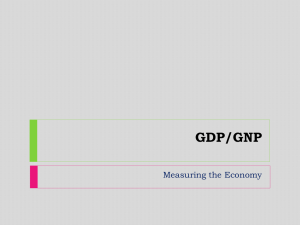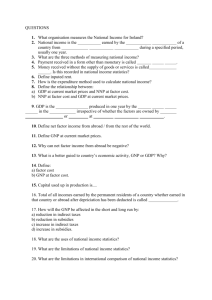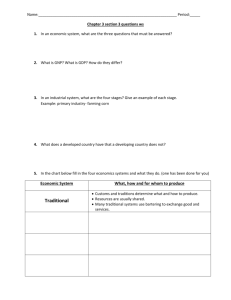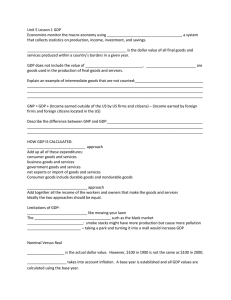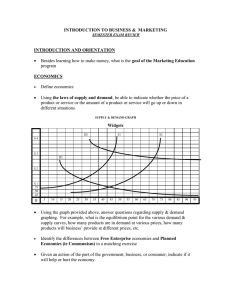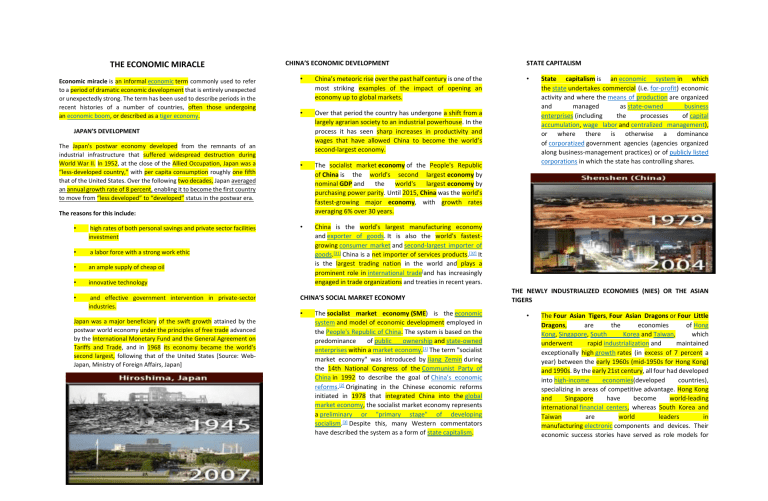
THE ECONOMIC MIRACLE Economic miracle is an informal economic term commonly used to refer to a period of dramatic economic development that is entirely unexpected or unexpectedly strong. The term has been used to describe periods in the recent histories of a number of countries, often those undergoing an economic boom, or described as a tiger economy. CHINA’S ECONOMIC DEVELOPMENT • China’s meteoric rise over the past half century is one of the most striking examples of the impact of opening an economy up to global markets. • Over that period the country has undergone a shift from a largely agrarian society to an industrial powerhouse. In the process it has seen sharp increases in productivity and wages that have allowed China to become the world’s second-largest economy. • The socialist market economy of the People's Republic of China is the world's second largest economy by nominal GDP and the world's largest economy by purchasing power parity. Until 2015, China was the world's fastest-growing major economy, with growth rates averaging 6% over 30 years. • China is the world's largest manufacturing economy and exporter of goods. It is also the world's fastestgrowing consumer market and second-largest importer of goods.[31] China is a net importer of services products.[32] It is the largest trading nation in the world and plays a prominent role in international trade[and has increasingly engaged in trade organizations and treaties in recent years. JAPAN’S DEVELOPMENT The Japan's postwar economy developed from the remnants of an industrial infrastructure that suffered widespread destruction during World War II. In 1952, at the close of the Allied Occupation, Japan was a “less-developed country," with per capita consumption roughly one fifth that of the United States. Over the following two decades, Japan averaged an annual growth rate of 8 percent, enabling it to become the first country to move from “less developed” to “developed” status in the postwar era. The reasons for this include: • high rates of both personal savings and private sector facilities investment • a labor force with a strong work ethic • an ample supply of cheap oil • innovative technology • and effective government intervention in private-sector industries. Japan was a major beneficiary of the swift growth attained by the postwar world economy under the principles of free trade advanced by the International Monetary Fund and the General Agreement on Tariffs and Trade, and in 1968 its economy became the world's second largest, following that of the United States [Source: WebJapan, Ministry of Foreign Affairs, Japan] CHINA’S SOCIAL MARKET ECONOMY • The socialist market economy (SME) is the economic system and model of economic development employed in the People's Republic of China. The system is based on the predominance of public ownership and state-owned enterprises within a market economy.[1] The term "socialist market economy" was introduced by Jiang Zemin during the 14th National Congress of the Communist Party of China in 1992 to describe the goal of China's economic reforms.[2] Originating in the Chinese economic reforms initiated in 1978 that integrated China into the global market economy, the socialist market economy represents a preliminary or "primary stage" of developing socialism.[3] Despite this, many Western commentators have described the system as a form of state capitalism. STATE CAPITALISM • State capitalism is an economic system in which the state undertakes commercial (i.e. for-profit) economic activity and where the means of production are organized and managed as state-owned business enterprises (including the processes of capital accumulation, wage labor and centralized management), or where there is otherwise a dominance of corporatized government agencies (agencies organized along business-management practices) or of publicly listed corporations in which the state has controlling shares. THE NEWLY INDUSTRIALIZED ECONOMIES (NIES) OR THE ASIAN TIGERS • The Four Asian Tigers, Four Asian Dragons or Four Little Dragons, are the economies of Hong Kong, Singapore, South Korea and Taiwan, which underwent rapid industrialization and maintained exceptionally high growth rates (in excess of 7 percent a year) between the early 1960s (mid-1950s for Hong Kong) and 1990s. By the early 21st century, all four had developed into high-income economies(developed countries), specializing in areas of competitive advantage. Hong Kong and Singapore have become world-leading international financial centers, whereas South Korea and Taiwan are world leaders in manufacturing electronic components and devices. Their economic success stories have served as role models for many developing countries, especially the Tiger Cub Economies of southeast Asia. • The East Asian model (sometimes known as statesponsored capitalism)[1] is an economic system where the government invests in certain sectors of the economy in order to stimulate the growth of new (or specific) industries in the private sector. It generally refers to the model of development pursued in East Asian economies such as Hong Kong, Macau, Japan, South Korea and Taiwan.[2] It has also been used to classify the contemporary economic system in Mainland China since the Deng Xiaoping's economic reforms during the late 1970s.[3] • Key aspects of the East Asian model include state control of finance, direct support for state-owned enterprises in strategic sectors of the economy or the creation of privately owned national champions, high dependence on the export market for growth and a high rate of savings. It is similar to dirigisme. • This economic system differs from a centrally planned economy, where the national government would mobilize its own resources to create the needed industries which would themselves end up being state-owned and operated. East Asian model of capitalism refers to the high rate of savings and investments, high educational standards, assiduity and export-oriented policy. THE TIGER CUB ECONOMIES • A developing country is a nation that fares poorly on the HDI and has low levels of industrialization. HDI stands for Human Development Index. A developing country is less developed than a developed country. • A developing country is a relatively poor agricultural country that is trying to become more advanced economically. It is also seeking to become more advanced socially. • • Tiger Cub Economies collectively refer to the economies of the developing countries of Indonesia, Malaysia, the Philippines, Thailand and Vietnam, the five dominant countries in Southeast Asia. Tiger Cub Economies are so named because they attempt to follow the same export-driven model of technology and economic development already achieved by the rich high-tech industrialized developed country of South Korea and nation Taiwan along with the wealthy financial centers of Hong Kong and Singapore, which are all collectively referred to as the Four Asian Tigers. THE TIGER CUB ECONOMIES EAST ASIAN DEVELOPMENT MODEL MEASURING GROWTH GDP & GNP WHAT IS GDP? • Gross Domestic Product (GDP) is the total monetary or market value of all the finished goods and services produced within a country's borders in a specific time period. As a broad measure of overall domestic production, it functions as a comprehensive scorecard of the country’s economic health. • There are several types of GDP measurements: MEASURING GROWTH AND DEVELOPMENT • For many years economic development was considered synonymous with economic growth. • Economic development is broader and much more encompassing view that economic growth. • Economic development relates levels of social and humanitarian achievement and income distribution, as well as a narrower measure of per-capita income. • Nominal GDP is the measurement of the raw data. • Real GDP takes into account the impact of inflation and allows comparisons of economic output from one year to the next and other comparisons over periods of time. • GDP growth rate is the increase in GDP from quarter to quarter. • GDP per capita measures GDP per person in the national populace; it is a useful way to compare GDP data between various countries. GDP EXPLAINED GROSS DOMESTIC PRODUCT/GDP is the market of all goods and services produced within a country in a year. GDP IN CONSTANT US DOLLARS FOR SELECTED ASIAN COUNTRIES WHAT IS GNP? • Gross national product (GNP) is an estimate of total value of all the final products and services turned out in a given period by the means of production owned by a country's residents. GNP is commonly calculated by taking the sum of personal consumption expenditures, private domestic investment, government expenditure, net exports and any income earned by residents from overseas investments, minus income earned within the domestic economy by foreign residents. Net exports represent the difference between what a country exports minus any imports of goods and services. GNP EXPLAINED One of the many metrics economists use to measure a country’s economic output. GDP VS. GNP MEASURING ECONOMIC DEVELOPMENT GDP is the market of all final goods and service produced within a country for a given period of time. This only measured everything produced in the country. (e.g. made in Australia) • GDP CARES ABOUT WHERE THE GOODS AND SERVICES ARE PRODUCED GNP is the market of all final goods and services produced by permanent residents of a nation for a given period of time. This only measures everything produced by the Australian citizens in Australia and abroad. (made by australian) GNP CARES ABOUT WHO PRODUCED THE GOODS AND SERVICES The Human Development Index (HDI) is a statistic composite index of life expectancy, education, and per capita income indicators, which are used to rank countries into four tiers of human development. A country scores a higher HDI when the lifespan is higher, the education level is higher, and the gross national income GNI (PPP) per capita is higher. It was developed by Pakistani economist Mahbub ul Haq, with help from Gustav Ranis of Yale University and Meghnad Desai of the London School of Economics, and was further used to measure a country's development by the United Nations Development Program (UNDP)'s Human Development Report Office HUMAN DEVELOPMENT INDEX HEALTH LIFE EXPECTANCY • • environment such as global warming and depletion of the ozone layer, should also be deducted, but these damages are hard to estimate. A measure used World Health Organization (WHO) summarizes the expected number of years to be lived in “full health”. The years of ill-health are weighed according to severity and subtracted from the overall life expectancy rate to give the equivalent years of healthy life. GREEN GNP • According to the latest data available from the WHO, Japanese men have the longest healthy life expectancy of 72 years among 191 countries, compared to 27 years for the lowest ranking country Sierra Leone. The Green National Product aims to allocate the omitted environmental degradation and resource depletion in the computation of the gross national product. • The green national product indicates whether the activities involved in the production process benefits or harms the economy and the welfare. • It revolves around social and economic factors which have been points of focus for many green movements. • The green national product is different from the traditional GNP because it addresses both sustainability and the welfare of the planet and its inhabitants. Thus, the aspect of green accounting has gained considerable attention in recent years around the world. MAKING COMPARISONS BETWEEN COUNTRIES • HUMAN DEVELOPMENT INDEX • One of the more recent approach developed to address that inherent shortcoming of GDP and GNP as growth and development measures is based on what is known as the “green” system of national accounting. GNP is the informal name given to national measures that are adjusted to take into account the depletion of natural resources (both renewable and non-renewable) and environmental degradation. The type of adjustment made to standard GNP would include the cost of exploiting natural resource and valuing the social cost of pollution emissions. Damages to the global • PPP method gives higher estimates of living standards for developing countries compared with exchange rate method. The reason is that GDP based on exchange rate valued depend only on their relative price of traded goods, whereas PPP method considers a basket of goods that include both traded and nontraded goods. • Nontraded goods are generally much cheaper in developing countries and this helps to lift the estimate of GDP for these economies. • PPP method is unaffected by exchange rate changes. • PPP method has become the preferred measure of GDP for country comparison. • One difficulty of PPP method is that it is costly to maintain since price movements need to be updated on a regular basis. EXCHANGE RATE METHOD Uses the rate between the local currency and the US dollar to convert the currency into US dollar equivalent. A country’s GDP and GNP per capita would then be valued accordingly, in US dollars. • • PURCHASING POWER PARITY (PPP) METHOD Develops a cost index for comparable basket of consumption goods in local currency and then compares with this prices in US for the same set of commodities. It is defined as a number of units of the country’s currency required to buy the same amount of goods and services that a dollar would buy in the US. Because PPP method uses a basket of many goods and calculates the relative price of these goods, many economists view this as a better measure of the relative standard of living than the conventional exchange rate method.

